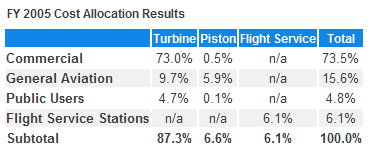Wed, Feb 14, 2007
Agency Worked With National Accounting Firm To Determine
Allocations
 How did the Federal Aviation
Administration arrive at its decision to increase fees operators of
smaller aircraft would pay under its proposed new funding scheme?
The FAA states it worked with accounting firm
PriceWaterhouseCoopers to designed what the agency calls "a simple,
transparent, thorough, and repeatable cost allocation
methodology."
How did the Federal Aviation
Administration arrive at its decision to increase fees operators of
smaller aircraft would pay under its proposed new funding scheme?
The FAA states it worked with accounting firm
PriceWaterhouseCoopers to designed what the agency calls "a simple,
transparent, thorough, and repeatable cost allocation
methodology."
The FAA used FY 2005 Cost Accounting System data -- which the
agency says is the most detailed and comprehensive cost data
available as the proposal was being developed -- to distinguish
between two types of users:
- Turbine-powered aircraft (jets and turboprops)
users drive most system costs because they fly in all weather, at
all times of the day, tend to be time-sensitive, generally compete
for the same air traffic control resources, and require complex air
traffic equipment and procedures.
- Piston aircraft and helicopter users, who
typically fly lower and slower than turbine pilots. These aircraft
typically fly less complex equipment, tend to be less time
sensitive, frequently fly under visual flight rules, and require
different types of air traffic control resources.
The FAA allocated the costs of more than 600 Cost Accounting
System projects between these two user types and determined that,
in most cases, piston users were responsible for only a share of
incremental costs. The total FY 2006 air traffic costs were
allocated as follows:

- 87% to turbine users,
- 7% to piston users, and
- 6% to flight service stations (expected to decline in future
years).
Within each group, the FAA divided costs among commercial,
general aviation and public users based on their share of activity.
In the terminal environment, the allocation looks at costs and
activity within groups of similarly-sized airports. As a result,
users of less costly facilities do not bear the costs of more
expensive facilities.
This table summarizes the FY 2005 cost allocation results,
according to the FAA:

Flight Service Station costs are not allocated among users,
because costs are expected to decline substantially in future years
(one assumes, due to increased privitization of the service --
Ed.) and the cost recovery proposal funds these costs from the
General Fund.
More News
Also: B-29 Superfortress Reunion, FAA Wants Controllers, Spirit Airlines Pulls Back, Gogo Galileo Van's Aircraft posted a short video recapping the goings-on around their reorganiz>[...]
Light Gun A handheld directional light signaling device which emits a brilliant narrow beam of white, green, or red light as selected by the tower controller. The color and type of>[...]
"The journey to this achievement started nearly a decade ago when a freshly commissioned Gentry, driven by a fascination with new technologies and a desire to contribute significan>[...]
"Our driven and innovative team of military and civilian Airmen delivers combat power daily, ensuring our nation is ready today and tomorrow." Source: General Duke Richardson, AFMC>[...]
Aircraft Conflict Predicted conflict, within EDST of two aircraft, or between aircraft and airspace. A Red alert is used for conflicts when the predicted minimum separation is 5 na>[...]
 Airborne 04.16.24: RV Update, Affordable Flying Expo, Diamond Lil
Airborne 04.16.24: RV Update, Affordable Flying Expo, Diamond Lil ANN's Daily Aero-Term (04.20.24): Light Gun
ANN's Daily Aero-Term (04.20.24): Light Gun Aero-News: Quote of the Day (04.20.24)
Aero-News: Quote of the Day (04.20.24) Aero-News: Quote of the Day (04.21.24)
Aero-News: Quote of the Day (04.21.24) ANN's Daily Aero-Term (04.21.24): Aircraft Conflict
ANN's Daily Aero-Term (04.21.24): Aircraft Conflict





